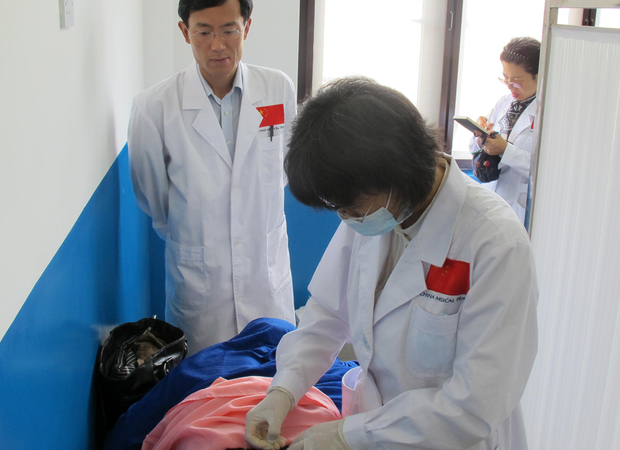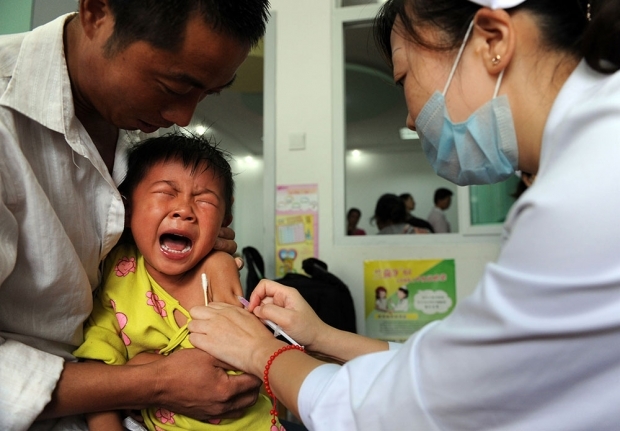While health officials in the United States and parts of Europe wrestle with a growing anti-vaccination, or “anti-vaxxer” movement, China is dealing with a less organized but similarly serious fear of immunizations. Social media reveals traces of vaccination anxiety across the country. On March 9, a man in China’s bustling manufacturing hub of Dongguan close to Hong Kong uploaded a photo of his latest immunization record to the popular social media site Weibo. “I just got a domestically produced vaccine for hepatitis B,” he wrote. “Now I am a little afraid. Domestic vaccines; are they really okay?” A woman in Chengdu, the capital of Sichuan province, wrote Feb. 15 that many of her friends were so nervous about vaccinations that they were either foregoing or delaying getting shots. She wrote: “They reject vaccines, feel suspicious, feel distrustful.”
Vaccine anxiety in the West has often centered on mistrust of the science: fears that injections could compromise one’s natural immunity or (debunked) theories that the shots can trigger autism. By contrast, Chinese people tend to have faith in foreign-made immunizations, but they worry that domestically produced vaccines are contaminated or substandard. A spate of 17 infant deaths at the end of 2013, initially suspected to have links to hepatitis B immunizations—made by several of China’s leading vaccine companies—has heightened concern. A government investigation subsequently blamed pneumonia, Sudden Infant Death Syndrome, and other causes for the fatalities, clearing the drug makers. The main company involved, Shenzhen Kangtai Biological Products, was giventhe green light to restart manufacturing its vaccines on Jan. 2, 2014. But the fear lingers. Feeding the worry is a general distrust of government data and state media reports, combined with a lively Internet sphere that acts as an ideal breeding ground for rumors and scares.
Recent research by Chinese health officials confirms social media’s role as an accelerator of anti-vaxxer anxiety. A study led by researchers at the Center for Disease Control and Prevention in Hangzhou, close to Shanghai, published Feb. 27, found that the crisis focused public attention and “negative sentiment online in China.” While media reports initially kindled worries, the report concludes, social media posts by “important opinion leaders” were also “very influential.” Even after the relevant vaccines had been confirmed safe by the government, people surveyed in 10 provinces showed vaccination rates for hepatitis B dropped 30 percent while other types of vaccinations in the national immunization program had also fallen 15 percent, the paper said. “It is possible that the negative effect will last long after the crisis,” it added.
These sorts of numbers understandably alarm the government. At a Jan. 3, 2014, press conference in Beijing, Wang Huaqing, one of the directors of the state-run National Immunization Program of the Chinese Center for Disease Control and Prevention, told journalists that he was “very worried” about rising doubts over vaccine effectiveness in China and that if the trend continued, the hard-won gains of several generations of Chinese disease prevention could be lost.
Features
06.06.13
Bad Medicine
And there is much to be lost. China launched a nationwide vaccination program in 1978 and offers free immunizations against more than 10 diseases, including measles, hepatitis B, diphtheria, pertussis, and tetanus. It has drastically reduced incidence of these diseases—but some have made a recent comeback. In 2014, China saw 107,000 people infected with measles, a huge jump from the 26,883 infected a year earlier in 2013.
Officials say that in addition to rising public concern about vaccinations, China has a problem with bad vaccination statistics, which are hampering efforts to stamp out disease. In a paper published in January 2015 and co-authored by Wang of the National Immunization Program, the government admitted that even though measles immunizations in China were officially said to be above 98 percent for all citizens, concerns had been roused by a survey of an unnamed county that found a reported rate of more than 95 percent for all residents but an actual penetration rate that was much lower. Only 22 percent of the children in that county between the ages of 8 months and 47 months had received a measles vaccination. The report stated that the vaccination rates only captured children who had been registered at clinics, while many children had never been registered, and were therefore never counted. It extrapolated that the problem could be widespread in China. The findings, the report said, “raised our concern that there may be a discrepancy between reported and real … coverage rates.”
In a strange twist, China’s flawed measles coverage data has become ammunition for at least one anti-vaccination advocate in the United States. The prominent anti-vaxxer Sayer Ji wrote in a Sept. 20, 2014, blog post that the fact that China has seen a resurgence of measles despite having such high immunization rates shows that vaccination simply doesn’t work. “Clearly the vaccines aren’t as effective as claimed,” Ji writes. But according to the recent government study, China’s problem is that it never had the high coverage rate it’s been claiming in the first place. On both sides of the globe, misinformation isn’t just a symptom of a health crisis—it’s a cause.




